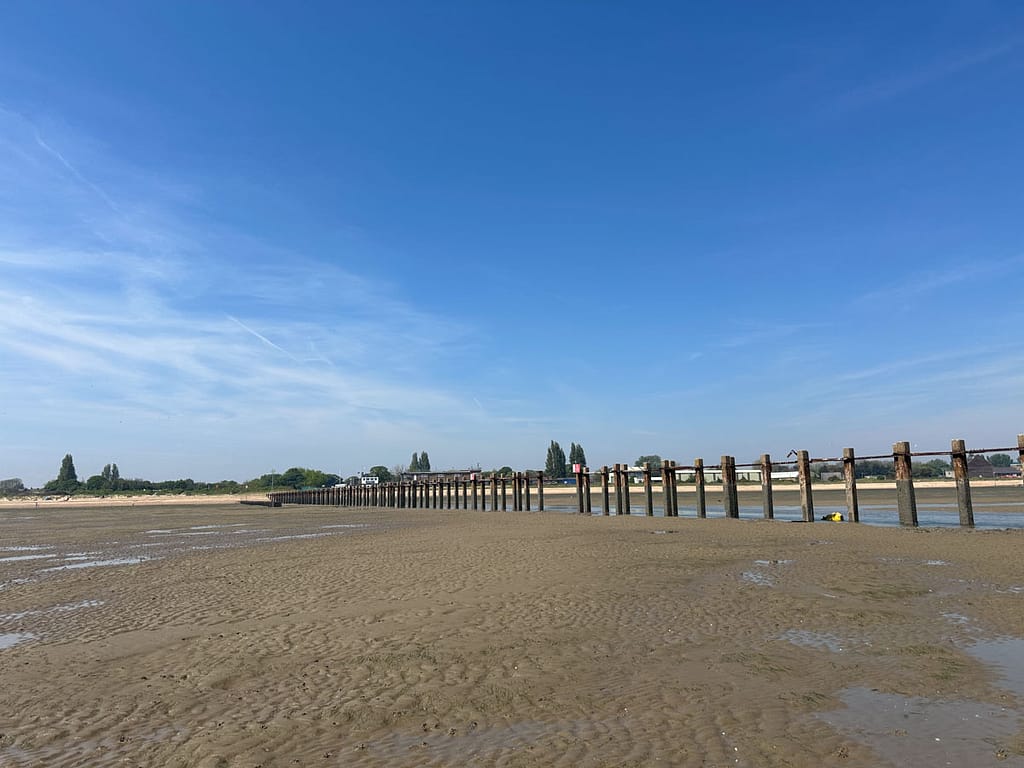SHOEBURYNESS BOOM: History, and Coastal Beauty in Essex
The Shoeburyness Boom, a prominent structure marking the MOD (Ministry of Defence) territory boundary, is a key feature of Shoebury East Beach. This less crowded alternative to Southend seafront has recently benefited from improved parking and a new café, and it is one of our favourite beaches in Essex.
We love the feeling of the sand beneath our feet at Shoebury East Beach. Walking beside the Shoeburyness Boom as the tide goes out, with the waves crashing nearby, is simply magical. If you’re looking for a quieter beach experience with a bit of WW2 history thrown in for good measure, keep reading. Just remember: do not cross the boom – it is tempting to explore, but it is strictly prohibited.
Please note that this post contains affiliate links. This means that if you purchase a product through one of these links, I may receive a small commission at no extra cost to you. This helps support my blog and allows me to continue creating high-quality content.


Planning Your Visit to the Shoeburyness Boom
📍 LOCATION: Shoebury East Beach, Shoeburyness, Essex
🚗 CAR PARKS (charges may apply)
- Entrance 1 East Beach Car Park, Shoeburyness, SS3 9SG – closest car park to the boom, but limited spaces.
- Entrance 2 East Beach Car Park, Shoeburyness, SS3 9AD – short walk to the boom, but closer to amenities.
🚻 TOILETS: A toilet block is situated close to Entrance 2 East Beach Car Park.
☕ FOOD & DRINK: The Eastbeach Cafe, located near Entrance 2 of the East Beach Car Park, offers a variety of hot and cold drinks (including alcohol), desserts, bacon butties, fish & chips, and more!
A Word of Warning (and a Learning Opportunity)


When visiting the boom, it’s crucial to be aware of the tide. It comes in very quickly and can easily strand unsuspecting visitors. Always check tide times before venturing out, and start heading back to shore well before low tide to avoid being cut off. Using a tide app or other reliable method is highly recommended. The speed of the incoming tide in this area is remarkable.
In fact, Shoebury East Beach is an excellent spot to teach children about the power of tides. Simply standing in one spot as the tide starts to come in provides a vivid demonstration of just how quickly the water can rise. It’s a learning experience that brings the concept of tides to life and emphasises the importance of respecting the sea. Just remember to supervise children closely and prioritise safety.
A Little History Lesson
The Shoeburyness Boom, also known as The Sheerness Boom, Thames Boom, or Thames Estuary Boom, is more than just a boundary; it’s a relic of wartime ingenuity.
The Original WWII Boom
The original Shoeburyness Boom was erected in 1939, at the start of World War II, its primary purpose was to prevent enemy submarines from entering the Thames Estuary and attacking merchant shipping. It also protected against mines, surface vessels, and potential invasion beachheads.
Stretching from Shoeburyness in Essex to Sheerness in Kent, the original boom consisted of wooden piles reinforced with concrete in the shallower waters near the shore, transitioning to an anti-submarine net in the deeper channel, with two gates allowed passage to friendly ships. This defence was supported by coastal batteries, including one at Shoeburyness, and the imposing Maunsell Sea Forts. These forts provided additional firepower and surveillance. If you’re interested in learning more about these fascinating structures, check out my blog posts on two of the most iconic: Shivering Sands Maunsell Fort and Knock John Maunsell Fort.
The Cold War Replacement

Between 1950 and 1953, the original boom was replaced by the current Cold War-era structure, built slightly west of its predecessor. The boom uses concrete piles and angle-iron straps. By the mid-1950s, the threat shifted to nuclear weapons, making the boom largely obsolete.
While the Kent side was eventually removed, portions of the Essex side remain, a testament to a time of heightened tension and the innovative solutions devised for national security. Today, these remnants serve as a landmark and a reminder of the area’s history, although they also pose a hazard to shipping and are marked on navigation charts. The boom also marks the boundary of the Ministry of Defence firing range, making exploration beyond it strictly prohibited.
Current Boom – Quick Facts
- Construction: Built between 1950 and 1953 (during the Cold War) to replace the original WWII boom.
- Materials: Two offset rows of concrete piles linked by angle-iron straps.
- Extent: Only the northern (Essex) section remains. The southern (Kent) section was removed in the 1960s.
- Length: The remaining Essex section projects 2.01 km from the shore.
- Gaps: Erosion has created some gaps in the line of piles.
- Historical Significance: Granted scheduled monument status in 2004.
Plan Your Visit to Shoeburyness Boom Today
Ready to explore a piece of history? I can’t recommend a visit to the Shoeburyness Boom enough! It combines everything I love: stunning coastal scenery (in my opinion, some of the best in Essex!) and a fascinating glimpse into wartime history.
And while you’re in the area, why not check out Southend too? My blogs – Things to do on Southend Pier, Southend Street Art Scene and 15 Reasons to Visit Southend – are full of inspiration for your itinerary.

